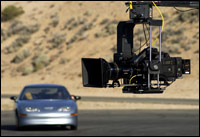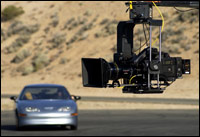At 25 years of age, Sundance is the country’s premier festival of independent film. But a lot has changed over that quarter century. Well, actually, one thing has changed: m-o-n-e-y. There’s a ton of Hollywood cash spent at Sundance, and I could see it everywhere I looked last week. The “VIP” corporate parties on Main Street. The piles of free stuff for celebrities. The Moviefone flacks in their garish red suits. The furry boots worn by nearly every female in town.
In the midst of the hype, plenty of not-so-glamorous films were being screened. In fact, some watchers called this the “year of the message movie.” The festival’s 120-plus features included serious explorations of terrorism, the death penalty, and, yes, the fate of our fragile planet.
I was at Sundance helping friends with a documentary project, and I’d heard that tickets were nearly impossible to come by. But after spending time in a couple of painfully early wait-list lines, I managed to get in, and get an eyeful.
A Mobile Murder Mystery
The first film I saw, Who Killed the Electric Car?, tracks the demise of a short-lived, much-loved piece of advanced technology. Though writer-director Chris Paine structured his film like a whodunit, it comes across as more of a love story.
Like a proud father, Paine — whose documentary credits include Faster, Looking Back, and Return to the Philippines — takes us back to 1990 to show us the electric car’s birth. That was the year the California Air Resources Board, in an effort to improve the state’s air quality, began requiring automakers to introduce nonpolluting vehicles. GM kicked things off that year with the Impact, whose unfortunate name soon changed to EV1. Eventually Honda, Toyota, and Ford unveiled their own models.
Throughout the first half of the film, a passionate band of devotees gushes about the cars. It’s the kind of crew you’d expect in a movie like this — environmental activists, progressive politicians, and “Americans Like You.” But they’re also joined by some unlikely allies, including engineers, GM salespeople, and Mel Gibson and Tom Hanks, recruited by the automakers to lend star power to their marketing.

I’m ready for my closeup.
Photo: Josh Knight.
Then the film shifts, becoming like a game of Clue. We witness the slow but inevitable death of the electric car, enabled by the rollback of the California mandate. Then we meet the lineup of suspects — automakers, oil companies, the Air Resources Board, even the American consumer — each of whom had their reasons for committing, or abetting, the murder. Although it’s obvious from the outset where Paine’s sympathies lie, he gives time to both sides, letting the evidence speak for itself. And it is damning: most of the suspects are guilty.
In the end, Electric Car seemed most successful at allowing viewers to fall in love with its cute, yet doomed, main character. By the time the last models were on their way to be demolished, some people around me were quietly wiping away tears. As the film ended, the audience responded with an emotional and enthusiastic standing ovation.
Though Sundance was the film’s world premiere, it will be distributed by Sony Classics, and producers Richard Titus, Tavin Marin Titus, and Dean Devlin hope it will reach wider audiences by summer.
PowerPoint to the People
One of the documentaries that seemed to generate the most buzz at Sundance was An Inconvenient Truth, a global-warming film starring Al Gore. The day before I saw it, I overheard two facts about the film: 1) it was so good, all the screenings had sold out; 2) it featured Gore giving a lecture with PowerPoint slides and charts.
Incongruous, yes, but sure enough, there’s more to this film than you might imagine. First of all, forget what you know about Gore. No longer the defeated candidate, he appears confident, witty, incisive, and fired up. Second, while the film makes no secret that it’s about a lecture — even showing Gore on stage in front of a massive screen — the presentation is sophisticated, entertaining, and visually appealing.
The compelling central speech highlights facts, photos, and anecdotes about our rapidly shifting global climate. It all points to a powerful conclusion: namely, that we’re almost out of time to address the problem. Within about 10 years, argues Gore, it will be too late to do anything about the most important challenge in human history.
That may seem like a lot to digest along with your popcorn, but director Davis Guggenheim — an experienced TV director (Deadwood, ER, NYPD Blue) — doesn’t clobber viewers with dry facts. He regularly cuts away from the lecture to introduce a more personal side of Gore. In fact, some of the film’s best moments take place on his family’s (no longer functioning) tobacco farm, where the man once known as “Al Bore” speaks emotionally about losing his older sister to lung cancer and nearly losing his young son in an auto accident. Both events, he says, helped spur an introspective journey that led him to more deeply consider humans’ relationship with the earth.
When you see this film — which Guggenheim and his producers hope to have in wide release by April — you’ll either be freaked out about the future or pissed off at how political and corporate leaders disregard evidence and silence their critics. Probably both. For its part, the Sundance audience was moved to tears and cheers. When Gore appeared on stage for a quick post-screening chat, you’d have thought it was the Democratic National Convention, as a collective roar swept everyone to their feet. Granted, Hollywood types are famously liberal, and I’d bet the vast majority of the ski-jacketed audience was already aware of the problem. But it felt like we were rediscovering a man who just might help us find a solution.
If Gore and Guggenheim achieve their stated goal of showing the film to every science class in America, perhaps we still stand a chance against global warming. And if Sundance helps them realize that goal, I guess I can live with the VIP parties and furry boots. But can’t someone do something about those red suits?


